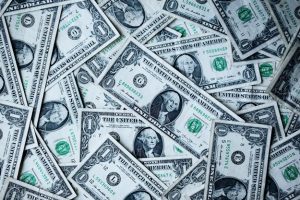The US Economy And Its Future Challenges In An Integrated World Economy
Dec 7th, 2024 | By Dr. Jim Eckman | Category: Featured Issues, Politics & Current EventsThe mission of Issues in Perspective is to provide thoughtful, historical and biblically-centered perspectives on current ethical and cultural issues.

The past three decades have produced an economy in America that is indeed the envy of the world. The Economist summarizes the financial and economic dynamic of the US economy: “In 1990 it accounted for about two-fifths of the GDP of the G7. Today it makes up half. Output per person is now about 30% higher than in Western Europe and Canada, and 60% higher than in Japan—gaps that have roughly doubled since 1990. Mississippi may be America’s poorest state, but its hard-working residents earn, on average, more than Brits, Canadians or Germans. Lately, China too has gone backwards. Having closed in rapidly on America in the years before the pandemic, its nominal GDP has slipped from about three-quarters of America’s in 2021 to two-thirds today.”
But it is imperative to remember that growth is not an inalienable right, but a “gift to be cherished and nurtured.” What are the challenges America faces in this integrated world economy? Are there policies now being advocated that could diminish the position of the US financially and economically in the world? Let’s consider several key challenges.
First, is the matter of tariffs. President Biden has used tariffs, especially in dealings with China, to both protect American industry but also to encourage changes in China’s economic behavior. Former President Trump also sees the tariff as a source of revenue and plans to accelerate the use of tariffs as a major policy of the US. Modern protectionists are desperate to find historical examples of tariffs promoting industrialization and economic growth. To this end, they increasingly argue that 19th-century America’s extraordinary economic success was fueled by high tariffs. Phil Gramm, senior fellow at the American Enterprise Institute, and Donald J. Boudreaux, professor of economics at George Mason University and the Mercatus Center, provide a helpful corrective to those politicians who believe that high and punitive tariffs are the key element of a robust American economy: “While 19th-century American industrial output grew fastest when tariff rates were falling, trade policy was nevertheless largely incidental to America’s astonishing economic expansion. Growth was unleashed in a country whose citizens had more economic freedom than any people who had ever lived. It was this freedom that fueled entrepreneurship and productivity. Combined with the country’s vast natural resources and openness to foreign investment and immigration, this freedom—not tariffs—produced the American economic miracle.”
It is true that America had high tariffs throughout the 19th century and experienced substantial economic growth. But tariffs were the nation’s primary revenue source until the ratification of the 16th Amendment—which authorized income taxes—in 1913. Alexander Hamilton, who supported industrial subsidies that Congress rejected, was skeptical of high tariffs since no tax revenue is collected on goods that tariffs keep out of the country; tariffs funded about 90% of the government. “Not until 1816 was a tariff enacted with any serious protectionist intent, according to Dartmouth economist Douglas Irwin. Protectionism peaked in 1828 with what came to be known as the Tariff of Abominations, which raised average tariff rates on all merchandise imports to an all-time high of 57.3%. During those years of rising tariff rates, U.S. industrial output grew at an average annual rate of 4%.” Several other important historical facts presented by Gramm and Boudreaux:
- With the election of Andrew Jackson and rise of the Democratic Party in a political backlash to the 1828 protectionist policy, tariffs were reduced. By 1860 the average tariff on all imports was 15.7%, having fallen by 73% over three decades. During that same time frame, the average annual rate of growth in industrial output was 6.7%—more than 40% higher than during earlier years when average tariff rates were rising.
- By 1860 industrial output was 563% greater than it was in 1830. This far outpaced the 144% U.S. population growth during the same period. Mr. Irwin describes the few decades preceding the Civil War—when average tariff rates were falling—as a period of “rapid industrialization.” He writes that between 1839 and 1859 the manufacturing sector expanded from about 15% to 21% of gross domestic product.
- During the Civil War, the U.S. government hiked tariffs to raise revenue for the war effort. By 1870 the average tariff stood at 44.9%. But from 1870 to 1890, average tariff rates on all merchandise imports fell again, this time to an average of 29.6%, a 34% decline. As average tariff rates fell during those two decades, industrial output grew at an average annual rate of 6%—one-third faster than during the rising-tariff-rate era of 1816 through 1830. In 1890 the Republican-backed McKinley Tariff raised industrial tariffs to nearly 50%, but in the 1890 and 1892 elections Democrats swept into power and reduced industrial tariffs. While America’s economy grew throughout the 19th century, the most rapid periods of industrialization occurred when average tariffs were falling.
Second is an examination of the standard defenses for a high tariff. The Economist has identified 5 major justifications for high tariffs. The three most important justifications need examination:
- Tariffs encourage more manufacturing at home and strengthen the economy. “But there is scant evidence of general tariffs providing such a lift to manufacturing. Tariffs draw scarce resources—both capital and labor—away from competitive firms and push them towards more protected ones.”
- Tariffs serve as a major revenue stream for the government. “But, when tariffs are increased, imports fall, lowering potential government revenue. In addition, retaliation from foreign governments would add to the headwinds for domestic producers now facing higher input prices.”
- Tariffs bolster America’s clout in trade negotiations. But, consider the results from six years of tariffs on Chinese products; China has only become a more formidable exporting power during that time. And, if tariffs are just used as negotiating leverage, the implication is that America ought to reduce them when trade deals are reached.
Finally, Daron Acemoglu, professor at the Massachusetts Institute of Technology, received the Nobel Prize in Economic Sciences this year. He has argued in an article entitled, “America Is Sleepwalking Into an Economic Storm,” that America is “Barreling toward us are three epochal changes poised to reshape the U.S. economy in coming years: an aging population, the rise of artificial intelligence and the rewiring of the global economy . . . Together, if handled correctly, these challenges could remake work and deliver much higher productivity, wages and opportunities — something the computer revolution promised and never fulfilled. If we mismanage the moment, they could make good, well-paying jobs scarcer and the economy less dynamic. Our decisions over the next five to 10 years will determine which path we take. Our dysfunctional political system, which is increasingly short-termist in its vision for the country, is unlikely to prepare us for these changes. Neither Vice President Kamala Harris nor former President Donald Trump is focusing on them with any seriousness in their election campaigns. Nor do we see comprehensive plans from either party to make the investments necessary to equip the American work force to deal with the coming challenges.”
- “The U.S. work force has never aged like this. In 2000, there were about 27 Americans above the age of 65 for every 100 Americans of prime working age (between the ages of 20 and 49). By 2020, this number had increased to 39. By 2040, it will have risen to 54. Because these changes are driven mostly by a decline in fertility, the U.S. work force will also soon begin to grow more slowly. If immigration into the United States is reduced, as seems likely no matter who wins the election, this will only contribute to the aging problem. Many jobs in the economy, such as in manufacturing and construction, require physical strength and stamina, which start declining as an individual ages, even with the kinds of health improvements we’ve seen. Workers typically reach peak productivity in their 40s. The young are also more entrepreneurial and willing to take risks, which many economies, not least America’s, sorely need.”
Over the past three decades, Japan, Germany and South Korea have aged almost twice as rapidly as the United States is aging right now, which means we have models to follow. The good news is that their economies have not grown more slowly than those of other industrialized nations and that several of their labor-dependent sectors, including cars, machine tools and chemicals, haven’t suffered.
The reason is simple: They introduced new machinery, including industrial robots and other automation technologies, to take over the tasks younger employees would have performed. These countries also invested in training workers so that they could take on the new tasks that complement automation . . . Alas, this isn’t what is happening in the United States. Investment in robots has increased rapidly, but it hasn’t been accompanied by adequate investments in people. The work force remains unready for taking on new tasks, including technical and advanced precision work.
- A.I. is an information technology, which “can automate a range of cognitive tasks that are typically performed in offices or in front of a computer. We need a broad national strategy so that A.I. doesn’t only automate work and sideline workers but also creates new tasks and competencies for them. This isn’t just because of the inequality that rapid A.I.-based automation could create or the fear of tech elites that the resulting joblessness will bring out the pitchforks. Evidence suggests that new technologies increase productivity much more consistently when they work with workers, enabling them to perform their jobs better and take on new, more sophisticated tasks. The secret sauce of Henry Ford’s innovative car factories wasn’t simply a more widespread use of better machinery but also a whole range of technical tasks that workers were trained for, such as repair and maintenance.”
Yet, even more than with aging, it looks like we’re going to mismanage this wave. The industry is locked into a race centered on “artificial general intelligence,” meaning the inchoate dream of producing machines that are just like humans and can take over all tasks from us. It remains preoccupied with using this technology either for generating digital ad revenue or for automation.
- “The era of rapid and largely unfettered globalization that followed the collapse of the Soviet Union is over. It benefited Western consumers and multinational corporations, which got access to inexpensive labor overseas. Workers, not so much. What will replace globalization is less clear. It could be a fragmented system, in which countries trade with allies and friends, with broadly similar flows to what we are seeing today (say, less of China and more of Vietnam). It could be one with high tariffs and much less trade. It could also be a combination of trade restrictions and industrial policies, such as the Biden administration’s Inflation Reduction Act and CHIPS Act, which are designed to encourage more investment and manufacturing, especially in advanced electronics, electric cars and renewable technologies, to stay in or to relocate to the United States. This change is also slow and has significant implications for workers. The promise of new manufacturing capabilities could lead to new job opportunities and possibly higher wages. On the other hand, new manufacturing competencies cannot be built overnight, and skills shortages can choke off industrial renewal. Alas, once again, the United States, especially its work force, isn’t ready.”
The good news here is that we have time, and if we grab the opportunities presented by aging, A.I. and the new globalization, they can all serve to improve one another. The skills that employers and schools need to tackle each of these huge shifts are similar. Moreover, the right kind of A.I. can greatly help us navigate the challenges posed by aging and the reshaping of globalization. The bad news is that these issues are not getting the attention they deserve, even though they are much more important for our future than debates about price gouging, taxes on tips or whether inflation is one point higher or one point lower. Unless we focus on them and act decisively, they will not just be mismanaged but also may spell a more dire future of work.
See The Economist (19 October 2024), p. 11; Phil Gramm and Donald J. Boudreaux, “No, Tariffs Don’t Fuel Growth” in the Wall Street Journal (17 October 2024); The Economist (12 October 2024), pp. 56-57; Daron Acemoglu in the Wall Street Journal (20 October 2024).


